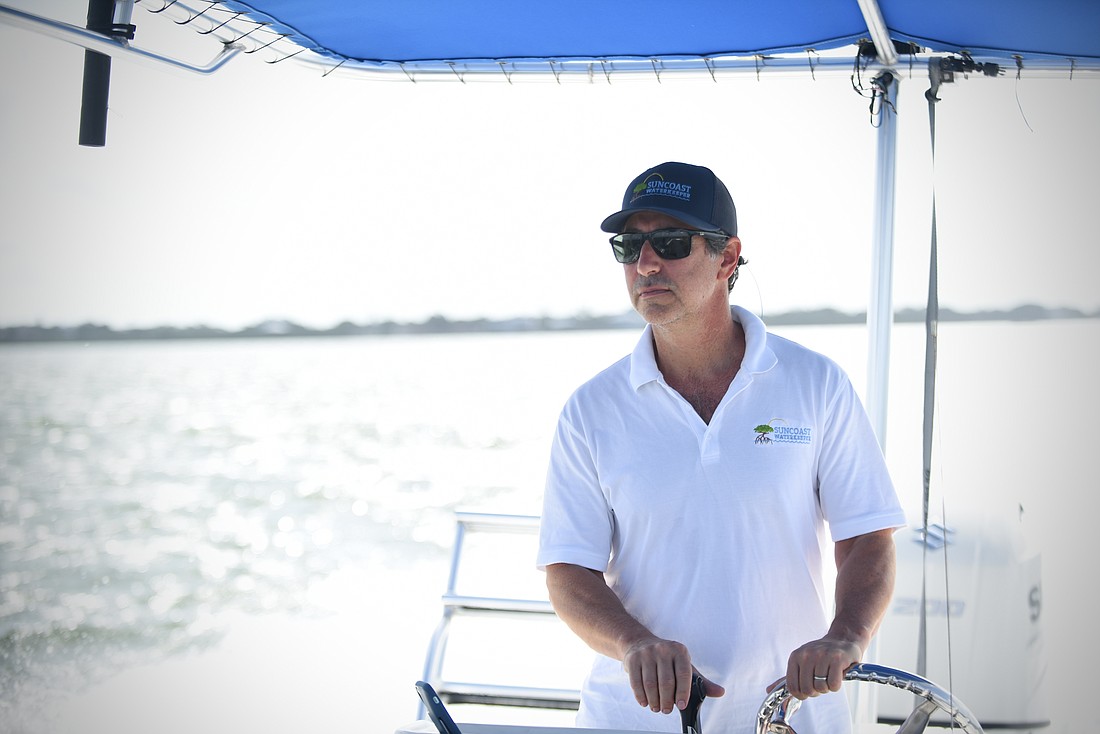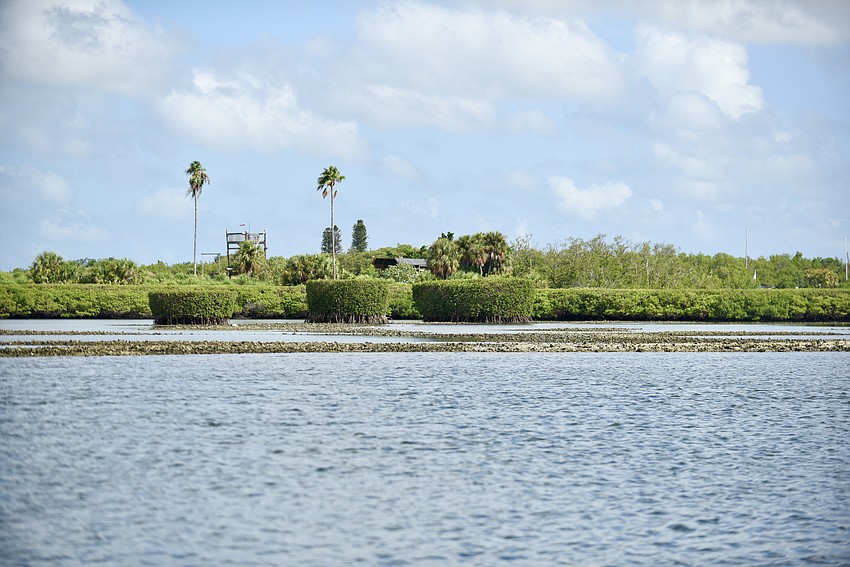- April 27, 2024
-
-
Loading

Loading

It was a choppy ride out to Longboat Key. A brisk wind had slightly tamped down the punishing August swelter, but it also made the 24-foot boat rumble and occasionally slam down on the rough waters of Sarasota Bay. As I winced and braced for impact, the four board members of Suncoast Waterkeeper barely noticed. They had bigger concerns than booking their next chiropractic treatment — stuff like how to preserve and restore local bays, rivers and wetlands.
The four are with a grassroots nonprofit whose territory covers Sarasota Bay, Lower Tampa and Terra Ceia bays, the Manatee River and local wetlands. Their organization is part of the Waterkeeper Alliance, a network of more than 350 such groups that encompasses 2.7 million square miles of waterways in 47 countries.
We sat on hard plastic benches, protected from the sun by a blue canvas cover. Board Chairman Rusty Chinnis was across the way. He’s a noted local conservationist and fly-casting instructor. Next to him was Richard Moore, a retired civil/environmental engineer. To my right was Abbey Tyrna, who signed on as executive director (and first paid employee) last year. She earned a doctorate in geography from Penn State and has devoted her career to water resources and wetland science. At the wheel was Justin Bloom, a highly experienced environmental lawyer who founded Suncoast Waterkeeper in 2012.
At 10 a.m., we embarked from Bahia Mar West Marina, which provides Suncoast Waterkeeper free space. During the relative quiet of the no-wake ride toward the bay, a hot topic was the previous night’s vote by the Manatee County Commission to cut back wetlands protections. The Waterkeepers bemoaned the commission’s 6-1 vote, contending that it favors the needs of developers over the will of citizens.
The commissioners approved plans to amend the Comprehensive Plan and Land Development Codes to shrink the required wetland buffer zones from a minimum of 50 feet to 15 feet. The order effectively means that “developers can build closer to mangroves,” Tyrna said. “They’re gonna want waterfront views.”
So, it’s only fitting that the focus of our excursion was mangroves. They’re vital to the bay’s general water quality, to maintaining a robust fish population, to invigorating seagrasses, mitigating storm surge, reducing erosion and minimizing red tide. The more of them that grow wild and free, the better.
It’s illegal to trim mangroves, let alone clear them, without a permit. But that doesn’t provide much of a deterrent. As we entered the bay, the Waterkeepers pointed out a long stretch of coastal green that had been cut flat at different heights, like hedges. There were even a few topiaries carved into rounded shapes. These manicured sections dominated a wide swath on the eastern side of the bay. They undoubtedly make for lovely water views, but the Waterkeepers wager that most, if not all, of the cutting was done without a permit. As we approached Longboat Key, we saw a few waterfront homes with mangroves artfully trimmed into fancy shrubs. One house’s shoreline was a brown splotch where mangroves had apparently been cut to the nub, possibly killing them.

What can Suncoast Waterkeeper do other than take note and lament? The group researches to see if the proper permits have been pulled. If not, which is usually the case, it reports the infraction to the proper governmental agency. Its efforts may result in a fine and — best case — an order to restore the mangroves, which can be costly to the offender.
When Aqua By the Way, a large residential development in Bradenton, violated a permit by over-trimming a vast section of mangroves and not removing the debris from the wetlands, Suncoast Waterkeeper took action. Its efforts resulted in a fine of $8,500 levied against Medallion Home. The Waterkeepers view that penalty as a proverbial drop in the ocean. “Just the cost of doing business,” Chinnis said ruefully. “Whatever punishment there is, is a slap on the wrist.”
Mangrove protection is just a small part of Suncoast Waterkeeper’s vast array of activities and concerns. The organization does much more than patrol waterways. In fact, the as-yet-unnamed boat goes out about once a week for a few hours. Volunteer captains travel to different locations and collect water samples, which are then analyzed by a private lab. Suncoast Waterkeeper purchased the skiff from Anna Maria Island Dolphin Tours, which offered the buddy price of $50,000 — and threw in the trailer for free. A grant from the William G. and Marie Selby Foundation covered the cost. The boat began patrolling in August.
Issues that fall under Suncoast Waterkeeper’s purview include sewage spills; algae blooms; stormwater pollution; seagrass depletion, which has been on the decline since its peak in 2016; development; and, of course, red tide. It works to keep big dredging and beach renourishment projects from running amok. Suncoast Waterkeeper also runs Eyes on the Suncoast, an online portal that allows users to report problems in local waters (and encourages them to post pretty pictures).
I asked Tyrna if she ever feels overwhelmed, or even discouraged, by the sheer enormity of the net her organization casts. “I think of it like this: Every issue we’re working on is a drop, and that drop is going to go somewhere,” she answered. “But I don’t focus on where it’s going. I try to make sure the drop has the best journey it can, but once it falls, I have to forget about it because there are so many other drops coming. We’re playing the long game. We’re not going anywhere.”

Of course, the occasional big win helps. Prior to Tyrna’s arrival, Suncoast Waterkeeper prevailed in lawsuits against five local governments for the illegal dumping of sewage: the city of St. Petersburg, the city of Bradenton, the city of Gulfport, the city of Largo and Sarasota County. Each was forced to stop releasing wastewater from treatment plants and sewer lines. The overall result? The legal actions have prevented more than 1 trillion gallons of wastewater from ending up in bays and wetlands, Tyrna said.
All told, Suncoast Waterkeeper spends more time navigating the environmental legal system than it does local waterways. Currently, the group is working to seek accountability from polluters and regulators involved in the Piney Point disaster, which in 2021 leaked 215 million gallons of wastewater from a former phosphate-processing facility into Tampa Bay. Bloom said the massive spill caused the biggest red tide seen in Tampa Bay in generations.
Further, Suncoast Waterkeeper has won suits to stop industrial pollution in the Whitaker Bayou watershed in northern Sarasota and penalize the wrongdoers. Along with other environmental groups, the nonprofit has challenged in court the permitting of the Velella Epsilon fish farm pilot project that’s proposed for 45 miles off the coast of Sarasota County.
Bloom steers the group’s legal initiatives, choosing teams of lawyers and sometimes litigating cases himself. He grew up in Baltimore and spent a lot of time on Anna Maria Island when his grandparents moved there in the 1970s. He’d kayak around and see sections of mangroves laid flat. His environmental consciousness came early. “I remember, when I was a young kid, walking around [housing] developments with my mother, and pulling up stakes,” he said with a chuckle. “I ultimately decided that there were better ways to protect the environment.”
Bloom attended New College of Florida, graduating in 1991 with a concentration in environmental studies. He earned his degree from Tulane Law School and has been practicing environmental law for nearly two decades. The attorney successfully represented many plaintiffs affected by the BP Deepwater Horizon oil spill. Bloom lived in New York City and worked for Hudson Riverkeeper, the first Waterkeeper organization (founded by fishermen in 1966), and as the Waterkeeper Alliance’s eastern regional director.
“I was living and working in a lot of places, and I reached a point where I wanted to put down roots,” he said. “So, I chose Sarasota, which had felt like home for a very long time.” When he relocated in 2010, there were no Waterkeeper groups on Florida’s west coast. After forming Suncoast Waterkeeper, he helped start up other chapters, including Tampa Bay Waterkeeper.
Bloom lives in an old house in Sarasota with his wife and two small children. He doesn’t take a paycheck from Suncoast Waterkeeper’s roughly $350,000 annual budget and pays the bills with a solo law practice and income from rental properties.
My spending several hours with a group of staunch environmental activists did not paint a flattering portrait of how the Suncoast stewards its waterways. This got me wondering just how bad things are. I posed the question to Tyrna.
“I would say that our bays are at a tipping point, and what we do now is instrumental in whether we end up looking like Indian River Lagoon,” she said, referring to an estuary on Florida’s east coast that’s beset by poor water quality, regular algae blooms, historic seagrass loss and more. “It’s either that or we salvage and repair what’s left.”
Bloom added: “The bays are very resilient, but we’ve got to give them a chance to recover and stop beating them up. We think this area has an incredible future, but we have to protect what is essentially our most important natural resource.”